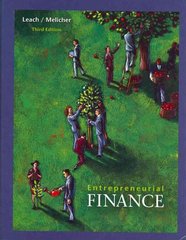Question
1. Use the information on Newell Rubbermaid shown here to answer the questions below. SHOW WORK. Current stock price $35.40 Beta 1.40 Dividend per Share
1. Use the information on Newell Rubbermaid shown here to answer the questions below. SHOW WORK. Current stock price $35.40 Beta 1.40 Dividend per Share (annual) $0.68 Earnings per Share (annual) $1.58 Total Shares Outstanding 270 million Assets $6.35 billion Liabilities $4.32 billion a. Find the dividend yield. Express as a percentage rounded to the tenths. b. Find the payout ratio rounded to the nearest whole percent, and explain what a payout ratio means. (Stating the formula is not an explanation.) c. Find the book value of the company. Newell Rubbermaid does not have preferred shares. d. Find the market capitalization of the company. Also, state whether this is a small-cap, mid-cap, or large-cap stock, and explain how you know. 2. Ben purchased 100 shares of stock from the Frankfurt (Germany) Stock Exchange at a price of ?52 per share when the exchange rate was ?1 = $1.30. He sold the shares less than a year later at a price of ?63 per share when the exchange rate was ?1 = $1.39. While he was holding the shares, he received ?2 per share in dividends. a. Find Ben?s total holding period return in U.S. dollars, rounded to the nearest percent. Show work. b. Show how the total return found in part (a) breaks down into its components. In other words, find the return earned on the stock in local currency; then find the return from changes in currency exchange rates. 3. Comparing stocks versus bonds: a. Generally speaking, which should you expect to provide more total return: stocks, or bonds? b. Generally speaking, which should you expect to provide more current income: stocks, or bonds? Explain. 4. You own 10 shares of Google, currently priced at $880 per share, for a total value of $8,800. Suppose that Google executes a 4-for-1 split. Fill in the blanks: After the split, you will own ______ shares, with a likely price of $_____ per share, and a likely total value of $______. 5. Suppose that the stock price of company XYZ has been increasing steadily at about 8% per year. In addition, about half the company?s profits are paid as dividends, and this dividend amount is also increasing steadily. Given this description, would company XYZ be better classified as (A) a growth stock, or (B) an income stock? Pick A or B and explain. 6. If you purchase the ADR of Sony (a Japanese stock), in which currency will the transaction occur? Do ADRs eliminate exchange rate risk? Explain why or why not. 7. A news report states that a stock is going to distribute a dividend on Thursday, January 31 to shareholders of record at the close of business on Thursday, January 10, making the ex-dividend date Tuesday, January 8. According to this information, what is the last date on which you could purchase this stock and still earn the dividend? Explain. 8. While a U.S. investor is holding a foreign stock denominated in a foreign currency, will that investor have a higher return if the U.S. dollar (A) appreciates versus the foreign currency, or (B) depreciates versus the foreign currency? Pick A or B and explain.
Step by Step Solution
There are 3 Steps involved in it
Step: 1

Get Instant Access to Expert-Tailored Solutions
See step-by-step solutions with expert insights and AI powered tools for academic success
Step: 2

Step: 3

Ace Your Homework with AI
Get the answers you need in no time with our AI-driven, step-by-step assistance
Get Started


